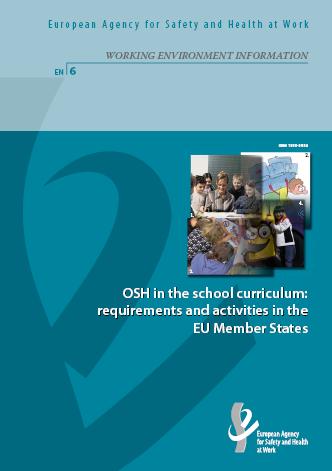 O relatório OSH in the school curriculum: requirements and activities in the EU Member States da European Agency for Safety and Health at Work, analisa a forma como os Estados-Membros da União Europeia têm vindo a incluir a Segurança e Saúde do Trabalho (SST) nos programas escolares dos respectivos países.
O relatório OSH in the school curriculum: requirements and activities in the EU Member States da European Agency for Safety and Health at Work, analisa a forma como os Estados-Membros da União Europeia têm vindo a incluir a Segurança e Saúde do Trabalho (SST) nos programas escolares dos respectivos países.
Esta inclusão (formal) é encarada como uma forma de reforçar o ensino em matéria de SST nas escolas e nos estabelecimentos de ensino superior.
De acordo com o relatório têm-se verificado alguns progressos e uma actividade significativa no que diz respeito aos níveis do ensino primário e secundário. O relatório aponta ainda alguns factores de sucesso para a integração da SST nos programas escolares.
Sugiro a leitura do documento, com especial enfâse a partir da página 101, cujo conteúdo é dedicado a Portugal.
The importance of taking a twin-track approach to the safety of young workers — through the classroom and in the workplace — is now well recognised in the field of occupational safety and health (OSH) and it has held a prominent position in the European Community health and safety strategy since 2002.
In support of the Community strategy goals on mainstreaming OSH into education, the European Agency for Safety and Health at Work has been gathering and analysing individual examples of good practice in the area. One finding of its previous work is the importance of formally including OSH and risk education in the education curriculum in order to ensure that it finds its way into the classroom in a systematic, consistent and enduring way. Therefore, the aim of this report is to present a review of the extent to which the Member States are taking the ‘curriculum’ approach, and the form it is taking.
This overview is timely, as reforms to the education curriculum are rapidly being implemented in the Member States, partly as a result of the European cooperation strategies on education that have been agreed by the Member States. In view of this, the report finds that there is both a convergence of the actions being taken to include risk education in the curriculum and a diversity in approach due to the differing national contexts and differing situations at the various levels of education.
The report provides both an overview of national situations and also suggestions for the way forward. As this is a rapidly developing area it is hoped that the report will come at a timely moment to assist all those working in the area, including OSH, education and curriculum authorities, and also those closer to and within the classroom who are seeking to promote risk education in schools, colleges and universities.
Jukka Takala
Director
European Agency for Safety and Health at Work
July 2009



